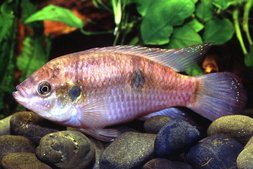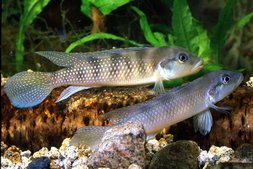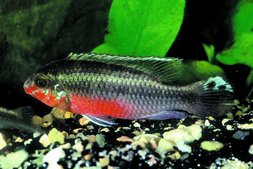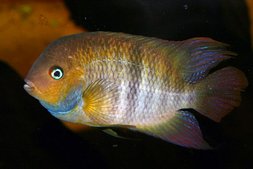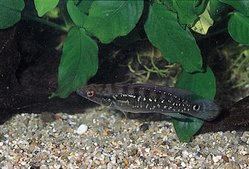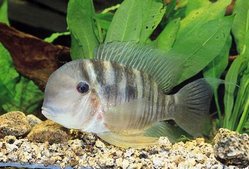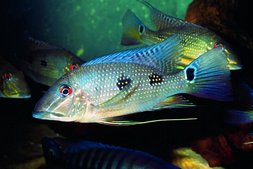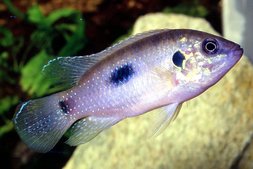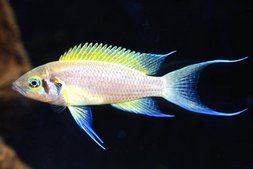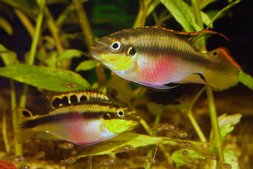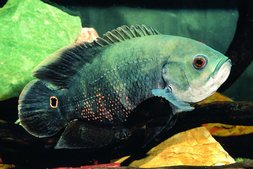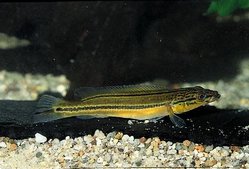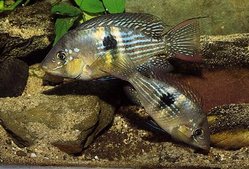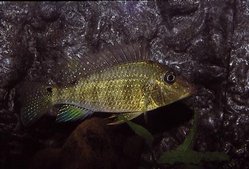Cichlids
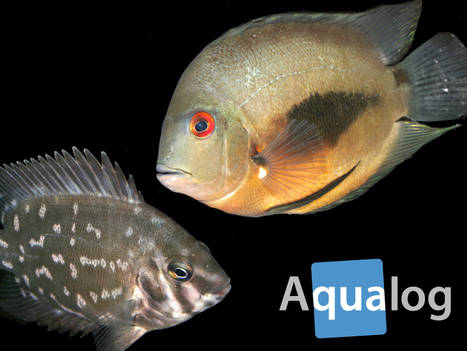
Cichlids (family Cichlidae) are a very species-rich family, with around 1,700 species in some 230 genera. Almost all of them live in fresh water. Many species are very important as food fishes all over the world, and some (tilapias) are bred in fish farms worldwide. The cichlids are also among the most important fishes in the aquarium hobby. They range from dwarf species that grow to only 4-5 cm long to very large fishes a good 80 cm in length. Some groups of cichlids are so important in the aquarium hobby that they will be dealt with in their own separate profiles: South American Dwarf Cichlids, Discus, African Mouthbrooding Cichlids, and Freshwater Angelfishes. These groups will not be discussed further in this profile.
Cichlids belong to the order Perciformes, the perch-like fishes, and some are predatory like the European Perch (Perca fluviatilis). Many are notorious for their “antisocial” behaviour, as they sometimes dig (a lot) and may attack other fishes in the aquarium, and this is usually associated with their breeding.
Important requirements
All cichlids practise brood care, and this means that they occupy breeding territories for at least some of the time and rigorously drive away all other fishes from these areas. The most important requirement of these fishes in the aquarium is that they are able to express this behaviour. There are so-called open brooders that lay their eggs on stones, wood, or plants in the open, and require the appropriate spawning substrate. Other cichlids are cave brooders that require a suitable cave as the focus of their territory. And finally there are the mouthbrooders, most of which defend a spawning territory for only a relatively short time, after which they swim around with the eggs (ovophilous mouthbrooders) or newly-hatched larvae (larvophilous mouthbrooders) in the mouth(s) of one or both parents, and don’t require any territory for this. Open and cave brooders normally practise biparental brood care, with both male and female participating in the care of eggs and young, while mouthbrooders do this only very rarely, with mouthbrooding usually being the task of the female alone. All brood care behaviour is species-specific and inherited. It is important to research the specific brood-care behaviour of each species kept, as the decor and the composition of the fish community in the aquarium needs to be arranged accordingly.
In addition these fishes need to be able to feed in their species-typical fashion, and this is especially important in the case of those species that sift the substrate for food. In order for them to remain healthy in the long term they must be provided with a substrate that consists, at least in part, of soft river sand (never builder’s sand!).
The chemical composition of the water is important for many cichlids. There are a large number of species that won’t tolerate acid water (pH less than 7). On the other hand most species that are found in acid water in the wild will tolerate neutral (pH 7) or slightly alkaline (pH 7.5-8.5) water. If in doubt aim for a pH in the 7-7.5 range. The hardness of the water is unimportant to the fishes in itself, but because the pH is a lot more stable in medium-hard to hard water than in soft, the water should be moderately hard to hard (total hardness more than 10 °dGH), at least for those species that won’t tolerate an acid pH (species from lakes Tanganyika and Malawi, plus Madagascan and Indian cichlids).
Appropriate feeding
Many cichlids are trophic specialists in the wild, but it has been found over hundreds of generations in the aquarium that the majority of species can be fed without problem on the usual types of food (dry, live, frozen). The only point to remember is that herbivores shouldn’t be fed a diet too rich in protein and fats, as this can sometimes lead to fatal digestive disorders. On the other hand, large carnivorous species require a nutritious diet in order to avoid becoming emaciated. Special foods for both trophic types are available in the pet trade.
Many cichlids become very tame and are exceptionally greedy so it is important not to feed them too much. The ideal is two to three feeds per day, using small portions that are eaten completely within five minutes. Adults should experience one or two fast days per week. It won’t hurt – for example when you are on holiday – if they aren’t fed at all for a number of days.
Correct maintenance
Large cichlids in particular have a high metabolic rate. For this reason regular large partial water changes are the most important element of maintenance. Ideally 1/3 – 2/3 of the water should be changed every week, refilling with fresh water of the same chemistry; at the same time the difference in temperature between the new water and the aquarium water should be as small as possible and never more than 2-3 °C. In aquaria with a low fish density, minimal germ population, and good biological filtration, water changes can be reduced to 1/5 of the total volume every 14 days. Longer intervals should not be employed in the long term.
Aquarium and tankmates
The majority of cichlids are relatively inactive fishes with only a moderate need to swim around. For this reason solitary individuals can be kept in relatively small aquaria. But because the majority of tanks will be home to at least one pair, often with other fishes present as well, the aquarium should be as large as possible in order to reduce the effects of any aggressive behaviour that occurs. Many specimens maintain a certain distance from one another even outside the breeding season. For example, a 20-cm long cichlid from Central America kept in a 120-cm long aquarium may murder all the other occupants, while the same community of fishes may live together in perfect harmony in a 180-cm long aquarium. Thus the tank size required will depend on the specific circumstances of every different aquarium. The data for individual species provided on the labels relate to keeping a pair in a species aquarium.
A well-designed underwater landscape will be very beneficial for the vast majority of cichlids, as these species possess a good spatial orientation capability and establish their territories based on visible “landmarks”. Piles of rocks (make sure they can’t be undermined!), bogwood, and large specimen plants (if necessary in pots) are good for this, although planting is often impracticable in the case of herbivorous species (tilapias, Uaru, etc.).
Life expectancy
Depending on the species cichlids can live for several years or even decades.
Size
Cichlids grow rapidly to start with and are usually sexually mature after 9-12 months at the latest. At this point they will be half to two thirds of their potential eventual size. Most cichlids should be full-grown by the age of 2-2.5 years.
Special details
Cichlids are full of character and have a very wide behavioural repertoire. In addition, many large species are exceptionally individualistic. Some specimens are meek as lambs and others real killers, even though they belong to the same species. Hence there is always an element of risk involved in keeping cichlids.





